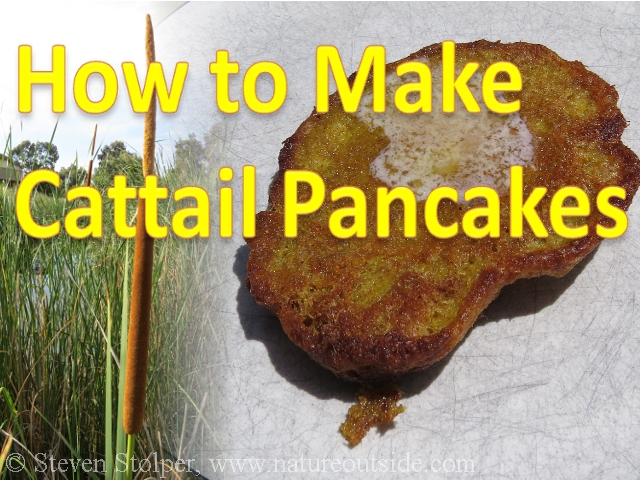
For the number of different kinds of food it produces there is no plant, wild or domesticated, which tops the common Cattail.
– Euell Gibbons1
Euell Gibbons famously called the common cattail the “supermarket of the swamps”. And I agree! You can eat the roots, the rhizomes, the young shoots and developing flowers. You can even eat the pollen!
Eating pollen is what we’ll talk about today. I want to show you how to make Cattail pancakes! Why? Because they’re fun! They’re delicious! They’re even nutritious!
When you eat a golden Cattail pancake it’s like inviting the sun for breakfast!
Achoo! Yum!
You might not have thought of eating pollen. But don’t be trapped by limited thinking! If you’re willing to expand your mind, the reward is a novel treat.
Not all pollen is safe to eat. But cattail pollen is a reasonably safe unless you have food allergies.
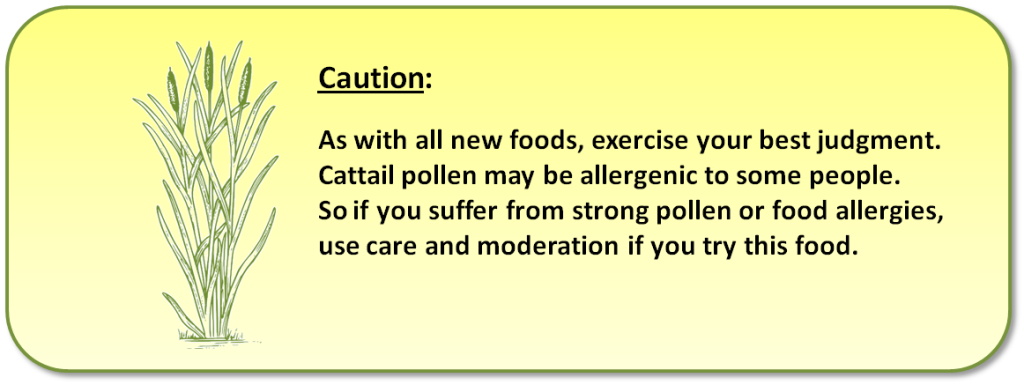
Before we cover harvesting and preparing cattail pollen, you have to know where to find it.
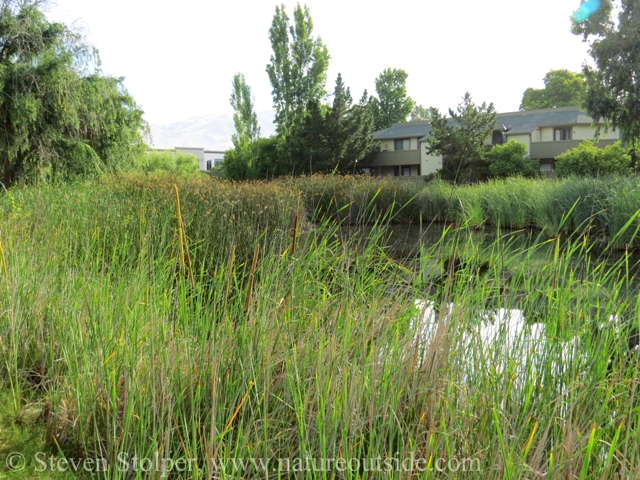
Cattails growing in a freshwater marsh.
You find Cattails (Typha sp.) in marshes and in brackish and freshwater wetlands. Near me I find Typha angustifolia, the Narrowleaf cattail.
Cattail flowers have two distinct parts. The male staminate flowers at the tip of the inflorescence produce pollen. The female flowers, located further down, produce the downy seed heads you are accustomed to seeing.
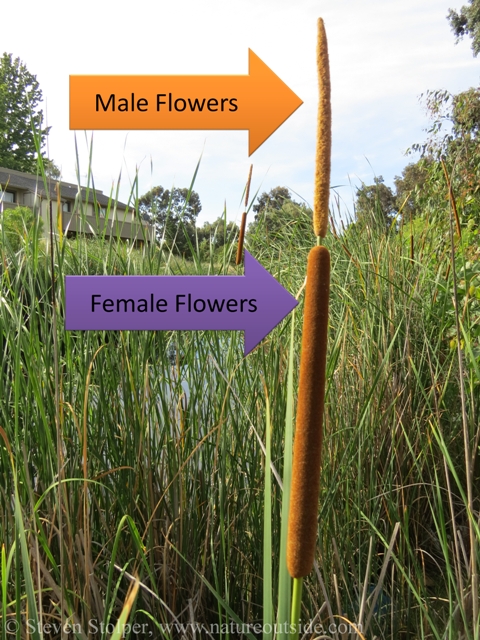
A cattail inflorescence has regions of male and female flowers
The flowers start to appear in May or June, depending on your location and climate. After the inflorescences emerge from their husks, inspect the male flowers for signs of pollen. If you gently shake the stalk, you should see a fine cloud of yellow pollen take to the wind.
It’s the pollen we’re after. The bright yellow powder is as fine as sifted flower. We need to collect it to make flavorful pancakes.
Harvesting Pollen
It’s 8:00 AM on a Saturday and I’m striding along the bank of a nearby marsh. The balmy air at this early hour hints at the oppressive heat to come. It will be the kind of lazy summer day that saps one’s energy for everything but cold drinks and ice cream.
But I chose early morning for my harvest not to avoid the heat, but the wind. It is best to harvest pollen when the winds are calm and the pollen drops willingly into your container.
The marsh cuts through a light industrial area of warehouses and two-story apartments. Not far from San Francisco Bay, the marsh is a remnant of the vast wetlands of Tule and Cattail that spanned miles around the ancient bay. Paper plates and candy wrappers strewn among the reeds spoil this oasis in the cement landscape. I plan to return later with a trash bag and remove as much litter as I can.

A freshwater marsh whose outlet eventually flows into San Francisco Bay
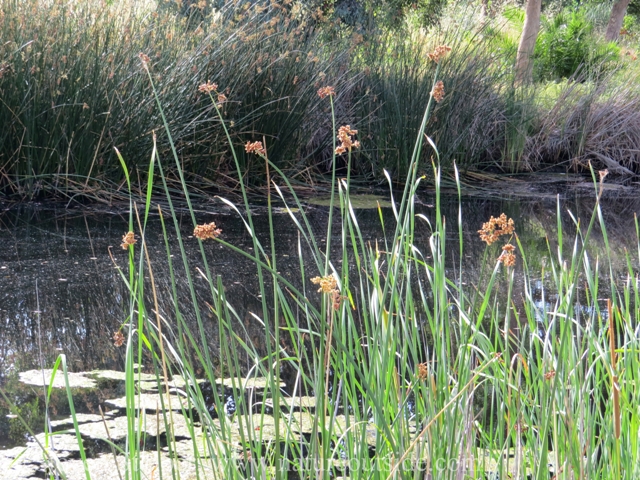
The marsh was kept as part of a flood control channel that was once a creek in a natural landscape
My goal is to secure the pollen without harming the plants or the ecosystem. I mention this because there are several ways to harvest cattail pollen. But some of them prevent the plant from reproducing that season. With nature under siege by man everywhere you look, I want to keep the plants viable and healthy. It will also ensure that the resource is available the next time I hunger for delicious pancakes.
My collection tool is a one-gallon plastic zip-lock bag. I have heard of people using one-gallon plastic milk jugs, and these will work as well. But for me the bag suffices.
Harvesting is straightforward. Hold the bag in one hand and slowly bend a flowering stalk with the other. Be careful not to destroy the flowers! If you lean the stalk too far over it will snap.
Insert the male part of the flower into the zip-lock bag. I like to seal the bag around the flower to contain as much of the pollen as I can. Many times, I need to insert the female part of the flower into the bag to keep the male portion far enough inside to contain the pollen. Otherwise, much of the pollen floats out the top of the bag. This isn’t great technique because the female flowers will collect some of the pollen from the bag. They may also deposit unwanted fibers into your pollen. But more often than not, I find myself inserting the entire inflorescence into the bag for convenience.
Once the flowers are inside, agitate them back and forth against the sides of the bag. I shake the stalk with one hand while I hold the bag with the other. I also use my hand to manipulate the flowers through the plastic. Remember not to lean the stalk too far over, or your enthusiasm will snap the stalk and the plant will be unable to reproduce.
Pollen floating out the top of the bag is the biggest problem. I don’t have any great solution for this, except practice. Another problem is accidentally dumping the pollen out of the bag as you maneuver the stalk inside. Try not to be clumsy. Be deliberate as you position the stalk and you will learn to avoid this problem.
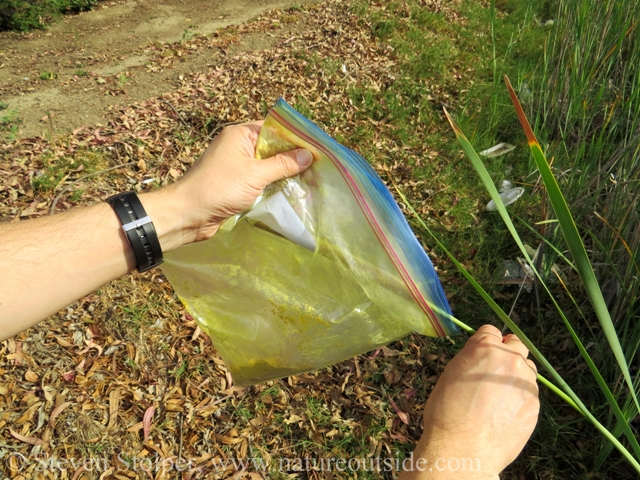
Inserting the inflorescence into the collection bag. I am putting both the male and female parts into the bag. It would be better not to put the female flowers into the bag.
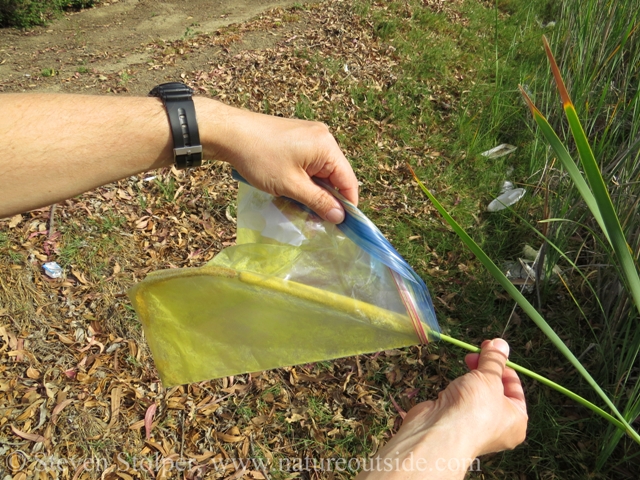
I agitate the stalk within the bag. I also strike the stalk and rub the stalk through the bag to shake off the pollen.
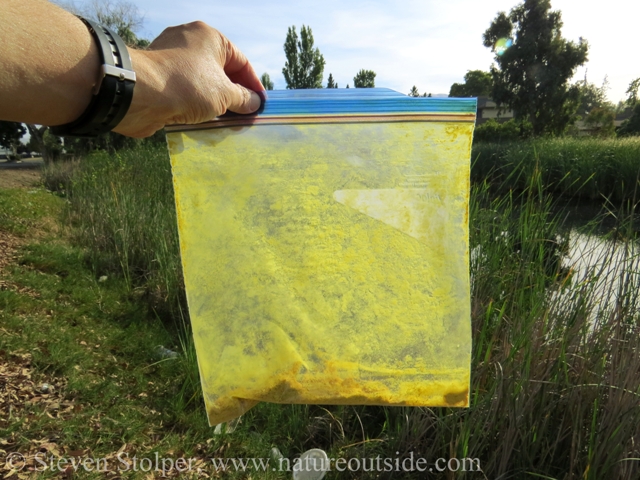
I collected this material from four large plants
It is a delightfully messy process. And your hands are soon dusted with golden powder.
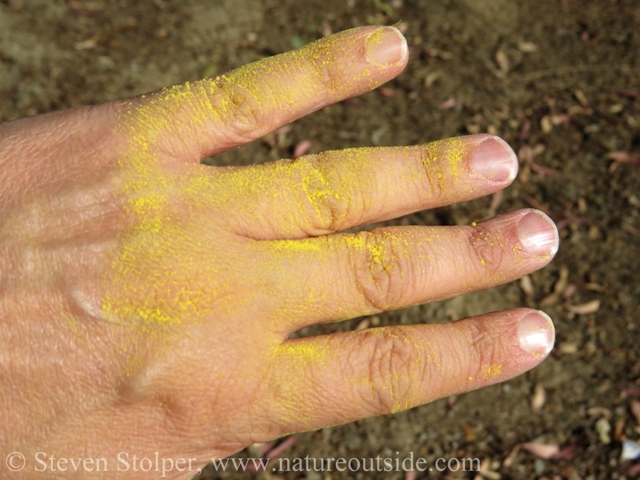
The pollen takes to the air while you harvest it. Some invariably lands on your hands.
Inviting the Sun to Breakfast
You can find a number of recipes you can make with cattail pollen. But my favorite is pancakes. They have a pleasing golden color and are highly nutritious. The pollen imparts a wonderful flavor that I am not gifted enough to describe.
Cattail pancakes seem extra hearty too. The pollen is high in protein and reported to be a source of calcium, iron, phosphorous, potassium and magnesium. Unfortunately, I am unable to find an authoritative analysis of the nutritional content of cattail pollen.
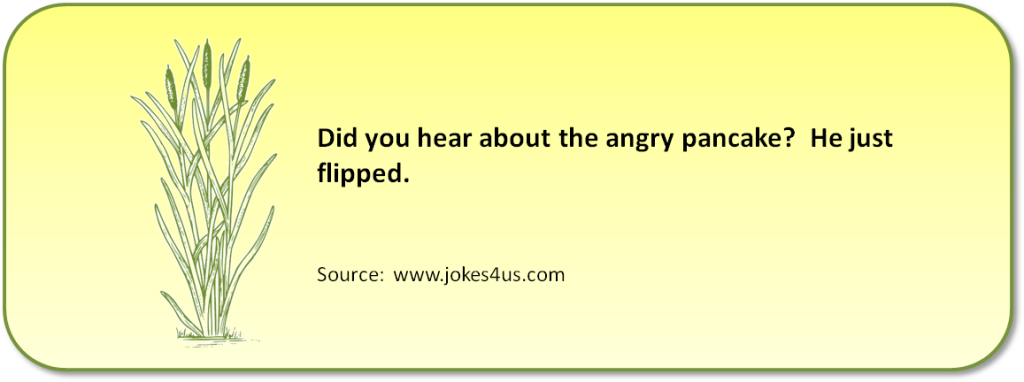
I store my cattail pollen in the refrigerator. If I’m in a hurry, I’ll reach into my plastic bag and scoop some out. But most of the time I sift it through a fine metal strainer to remove seeds and plant fiber that fall into the bag during collection. I use a metal strainer like the one I use to leach acorns. But most of the time I just don’t care. I welcome the extra fiber and flavor.
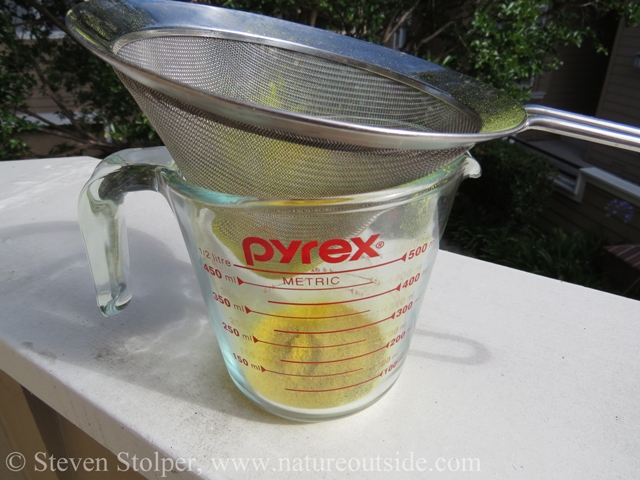
Straining the pollen removes fiber from the plant that fell into the collecting bag
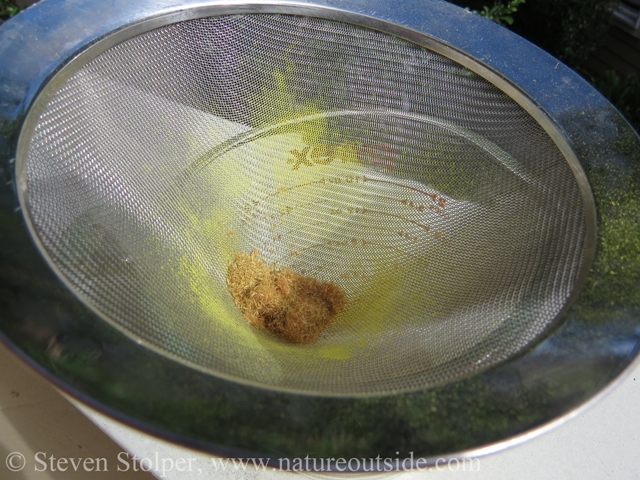
The strainer traps the fiber and some pollen
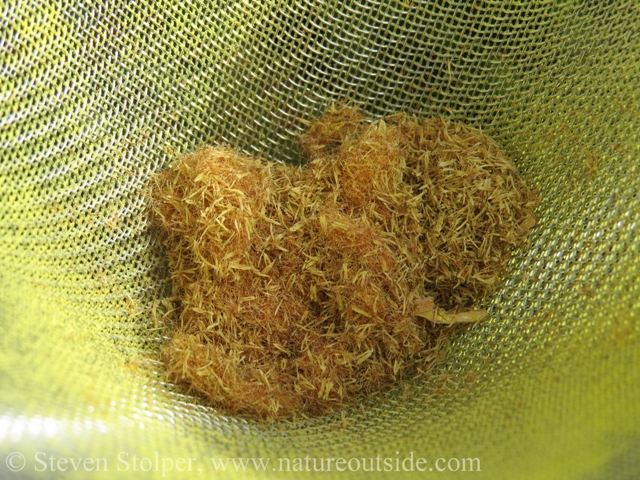
The fiber from the cattail plants. I shake it a bit to capture the last remaining pollen.
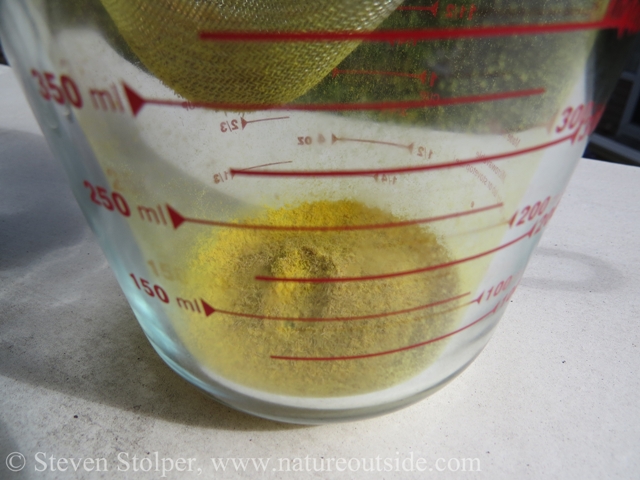
The filtered cattail pollen is like the finest flour
I use a 1:1 ratio with pancake mix. The pollen must be mixed with other flower because it will not bind to itself. Bushcraft expert Ray Mears mentions that families in Britain collected cattail pollen during World War II, when wheat flower was in short supply. They used the pollen to extend their flower ration3.
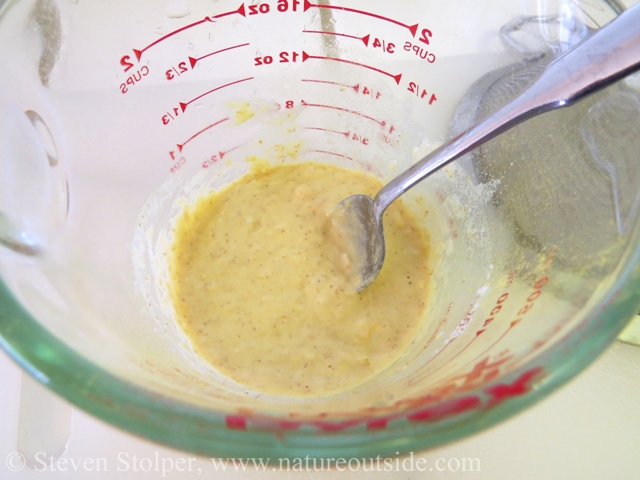
Batter made with cattail pollen has a beautiful gold color
Then it’s into a cast iron skillet…
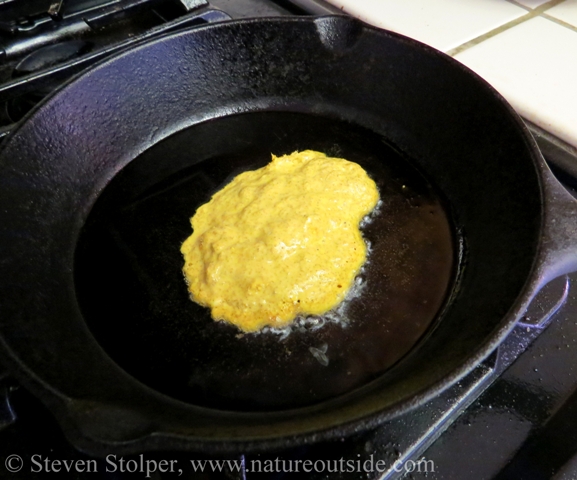
The golden batter sizzling on the skillet promises good things to come
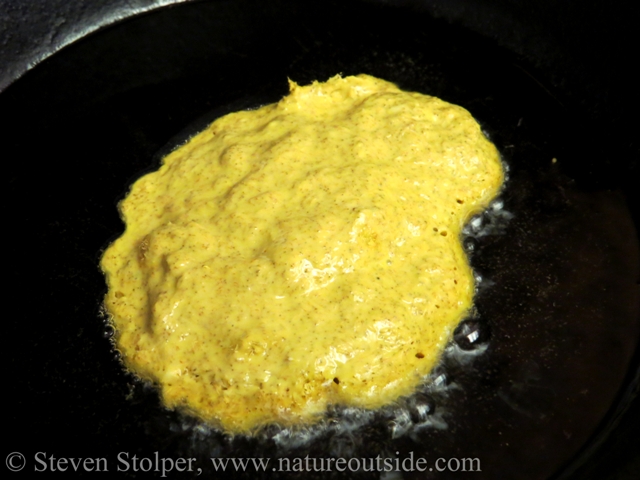
Cattail pollen raises the protein content of the pancakes
Viola!
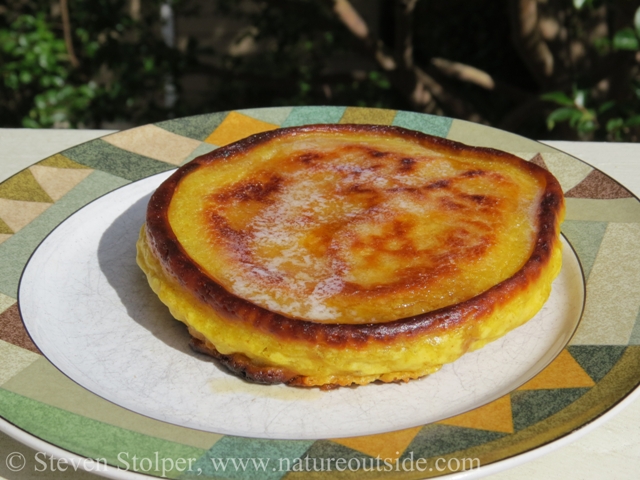
I love the beautiful gold color!
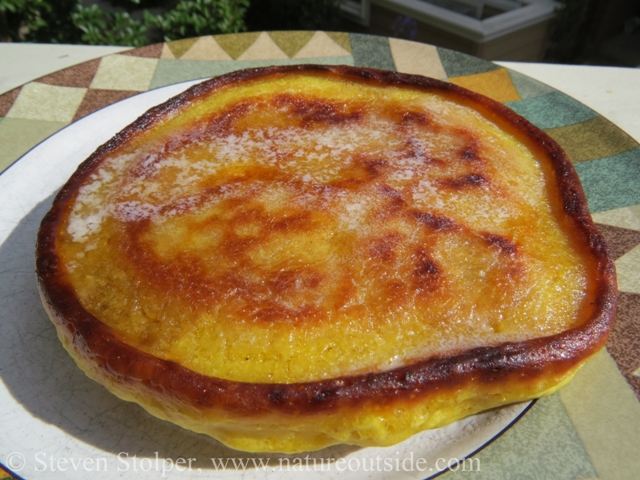
The cattail pollen (and possibly the fiber) adds extra flavor to the pancakes
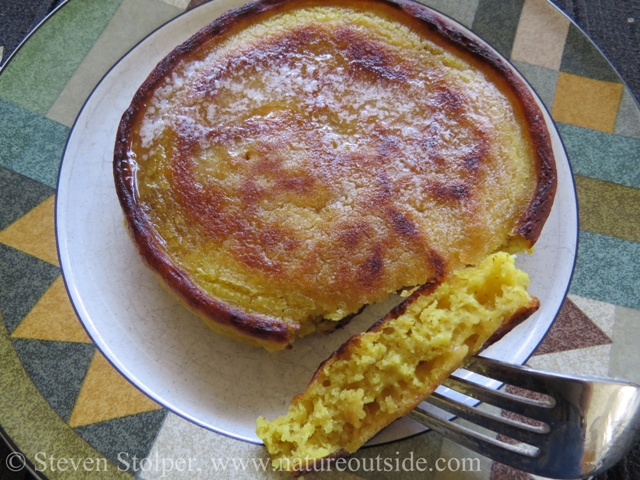
A healthy and delicious way to start the day
Enjoy your pancakes. But remember to harvest responsibly! Those of us who love nature should act as stewards for our wild places. It is up to us to set a good example and make certain our activities don’t damage the natural environment.
Bon Appétit!
More Wild Edibles on NatureOutside
How to Make Acorns into Food (Part 1)
References
- Stalking The Wild Asparagus, Euell Gibbons
- USDA NRCS Database (Cattails)
- Wild Britain with Ray Mears (DVD)
- The Forager’s Harvest: A Guide to Identifying, Harvesting, and Preparing Edible Wild Plants, Samuel Thayer



This is a very interesting and detailed post but …also a great bushcraft recipe! Thank you! Ciao Mattia!
Thanks, Mattia! If you make the pancakes please let me know how you like them.
Ok, I give up. Why can you only use the pollen and not the fibrous flowers? Couldn’t you use the whole head to make your flour?
MillenniumMan, you can certainly keep the fibrous material in your flour. I am referring to the plant fiber that you collect incidentally with the pollen. Sometimes I leave a little in my flour because I think it adds a stronger taste.
But I do not recommend using the whole flower head. Both the male and female parts are too fibrous, especially the female head. The plant fiber will not harm you if you consume it. But it is not nearly as nutritious or as tasty as the pollen. You are in effect adding “filler” to your flour. It also destroys the resource because the plant cannot reproduce that season. So I do not recommend this approach.
There are no hard and fast rules. So feel free to experiment and do what works best for you. But I would avoid using the entire inflorescence for the reasons I mention above.
Indeed, I always did. It makes a hairy looking pancake, but who cares?
I collected some last summer and made bannock with it and AP flour. They were good.
I noticed you didn’t mention bugs. I collect the pollen in the same plastic bag and also collected a lot of bug, grubs, little worm like things. I spread the pollen out on the table and removed most of them.
I don’t mind a few bugs but other may…
Thanks
Thanks for the comment, Chris! You make an interesting point about insects. I didn’t mention them because I rarely find insects in the pollen I collect.
I usually gather pollen from the plants growing farthest up the bank. It’s just more convenient. Perhaps the drier conditions make the flowers less attractive to insects. I place only the male flowers in the bag (when I can) to minimize plant fibers falling into my harvest. This may also help to keep out insects.
Maybe I’m just lucky. If I do have insects mixed with the pollen, I separate them before storage when I sift through a fine metal strainer to remove seeds and plant fibers.
Starch and gluten from the Typha roots can be used to bind the pollen.
Thanks for your comment, Bob Joe! I’ve never tried using starch from cattail roots to bind the pollen. Once you bind it this way, what do you do next?
The way you use it is you extract the starch from the roots by bruising them and wringing out the roots in water. The starch will sink to the bottom, then you remove the water.
The starch can simply be mixed into any dough or batter you make. You may have to reduce the liquid in the dough by a little, but you won’t have to add wheat flour, as the starch also contains gluten.
This is very helpful. I will try it, considering I can’t have wheat flour.
Lizzy, if you can’t have wheat because you are allergic to it (your body produces antibodies to proteins found in wheat), then Bob’s technique may work for you. But if you avoid wheat because you have celiac disease (a specific protein in wheat — gluten — causes a different kind of abnormal immune system reaction), then Bob’s suggestion won’t work for you. Bob mentions that the starch in cattail root also contains gluten.
You are correct. However, I am certain it’s not the gluten my body reacts to. Thank you for your concern and reply 🙂
This is so cool! I stumbled across this while looking up cattail images with my daughter for school. I’m always down for doctoring up plain pancake batter with more nutritious additions. I’ve also started learning about how to use wild plants for food, such as poke weed, dandelions and sunchokes. Now you’ve got me intrigued to find out more about using cattails for more than just pancakes. Thanks, Steve, for this article and recipe. This will be fun! My 8 yr old daughter loved your helpful pictures as much as I did.
Laura, I’m glad you and your daughter enjoyed the article. It sounds like you’re already beginning to have fun with wild edibles. The two of you will find that there is always something new and wonderful to learn. Have fun!
In Iraq the peoples of marshlands make sweet from Typha pollen grains called Kheret.
Ahmed, thank you for your comment! I was unfamiliar with khirret until you mentioned it. I did some research and it seems to be a mixture of the pollen with sugar or date syrup that is steam cooked. I think I will try to make some!
Hi Steve! The fibrous remains from sifting the cattail pollen look like they would make good fire starting tinder. Almost as good as cattail head later in the season.
Tommy, that’s a great thought! I’m going to try it next time I collect cattail pollen.